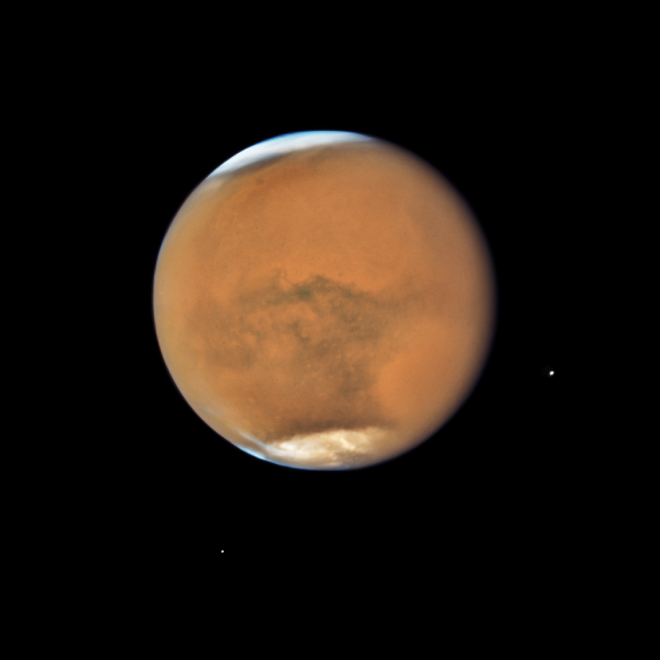How to find Mars in the sky
July 27, 2018
By Amy Sayle
You may have noticed that Mars has been in the news a lot lately: It’s at opposition! There’s a big dust storm! There’s a body of liquid water under the south polar ice cap! (However, if you’ve heard “Mars will look as big as the full moon!” then it’s probably time to reconsider your information sources.)
If you’re curious to see Mars in the night sky, this is what to look for:
1) Mars is currently very bright.
Now (July 27, 2018) and for a number of weeks to come, Mars will look brighter than any star in the night sky and brighter than any planet except Venus. Why is Mars so bright? The distance between Earth and Mars changes quite a bit as a result of their orbits around the Sun, and Mars is relatively close right now (but still more than 35 million miles away).
Two of us from Morehead (one with less-than-perfect vision) easily, EASILY picked out Mars last night from the sky above Carrboro, in spite of nearly blinding glare from parking lot lights. As long as Mars isn’t behind something, like a tree or building or cloud (or below the horizon), you cannot miss it.
2) Mars will look orange or reddish.
Or “apricot-colored,” my colleague insists. Mars is called the Red Planet for a reason. It will not look white to your eyes.
3) Mars will probably be shining steadily.
Whereas stars twinkle. Don’t mistake Mars for its rival, the star Antares, which is a similar color, but will be twinkling. Also, Mars will look much brighter than Antares.
4) Mars will appear in the direction of…
…Well, it depends on what time you’re looking. As of this writing, Mars is at opposition, meaning Mars lies opposite the Sun in the sky from our point of view on Earth. So as the Sun sets in the west, Mars rises in the east. As the night progresses, Mars passes across the sky, eventually setting in the west as the Sun rises in the east.
It also depends on what date you’re looking. As the nights go on, Mars will rise earlier and appear higher in the sky at nightfall.
If you’re looking tonight (July 27, 2018), look for the full moon. You’ll find Mars in that same part of the sky.
Note that in spite of a claim that’s been circulating for years, Mars will not appear as big as the full moon. Ever. Don’t be fooled by the image in this blog post. That’s a Hubble Space Telescope image of Mars—not what you’ll see when you glance up at the sky.
Look for more news about Mars this fall. Shortly after Thanksgiving, NASA’s InSight mission will land on Mars to study its deep interior and help us understand more about how rocky planets form and evolve.
To see Mars – and other planets and celestial wonders – through a telescope, please join Morehead for a skywatching session (weather permitting):
- Sunday, August 12, 2018, at Dorothea Dix Park, Raleigh. This free session runs from 9 to 11 p.m. Please register online.
- Friday, August 24, 2018, at Historic Stagville, Durham. This event starts at 8 p.m. with African sky stories, followed by skywatching.

